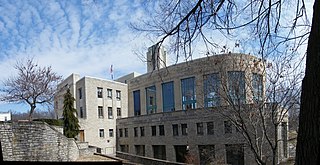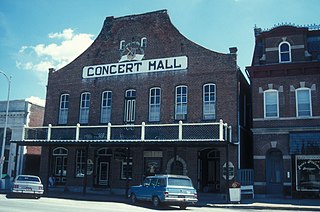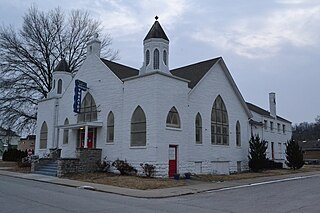
Clay County is located in the U.S. state of Missouri and is part of the Kansas City metropolitan area. As of the 2020 census, the county had a population of 253,335, making it the fifth-most populous county in Missouri. Its county seat is Liberty. The county was organized January 2, 1822, and named in honor of U.S. Representative Henry Clay from Kentucky, later a member of the United States Senate and United States Secretary of State.

Excelsior Springs is a city in Clay and Ray counties in the U.S. state of Missouri and part of the Kansas City metropolitan area. The population was 10,553 at the 2020 census. It is located approximately 30 miles (48 km) northeast of central Kansas City, Missouri.

The Elms Hotel and Spa is a historic resort hotel at Regent and Elms Boulevard in Excelsior Springs, Missouri. It is listed on the National Register of Historic Places. It is located in The Elms Historic District.

There are nine historic districts in Meridian, Mississippi. Each of these districts is listed on the National Register of Historic Places. One district, Meridian Downtown Historic District, is a combination of two older districts, Meridian Urban Center Historic District and Union Station Historic District. Many architectural styles are present in the districts, most from the late 19th century and early 20th century, including Queen Anne, Colonial Revival, Italianate, Art Deco, Late Victorian, and Bungalow.

Hermann Historic District is a national historic district located at Hermann, Gasconade County, Missouri. The district encompasses 360 contributing buildings, 4 contributing structures, and 3 contributing objects in the central business district and surrounding residential sections of Hermann. The district developed between about 1838 and 1910, and includes representative examples of Greek Revival and Classical Revival style architecture. Notable buildings include the Eitzen House (1855), Potnmer-Gentner House (1848), Hermann City Hall (1906), Strehly House (1845), Concert Hall (1877), The German School (1871), and Gasconade County Courthouse (1896).

First Methodist Church, also known as Mt. Zion Methodist Church, First Methodist Episcopal Church, and Marietta Baptist Church, is a historic Methodist church located at 114 N. Marietta Street in Excelsior Springs, Clay County, Missouri. It was built in 1948, and incorporated portions of the existing 1903 Gothic Revival style church. The interior is based on the Akron Plan. The church features square tower pavilions topped by large octagonal cupolas supported by buttresses.

Delaware Avenue Historic District is a national historic district located at Wilmington, New Castle County, Delaware. It encompasses 180 contributing buildings and 1 contributing structure developed in the late-19th and early-20th centuries. The district is primarily residential and includes a variety of Victorian-era mansions and large dwellings in a variety of popular architectural styles including Italianate, Queen Anne, Colonial Revival, Classical Revival, and American Four Square The houses are detached or semi-detached and are primarily three stories in height with extensive wings to the rear. The district also includes 20th century apartment complexes. Also located in the district is the St. Stephen's Lutheran Church and the Sailors and Soldiers Monument. The separately listed Howard Pyle Studios are also located in the district.

Cool Spring Park Historic District is a national historic district located at Wilmington, New Castle County, Delaware. It encompasses 316 contributing buildings, 3 contributing structures, and 3 contributing objects in located in and around Cool Spring Park in Wilmington. It developed in the late-19th century as a middle class residential area. They are primarily semi-detached dwellings in a variety of popular styles including Gothic Revival and Queen Anne. Also located in the district is the Cool Spring Pumping Station associated with the Cool Spring Reservoir, Cool Spring Elementary School, and Knights of Pythias Hall.

The Newmarket Industrial and Commercial Historic District encompasses the heart of a distinctive 19th century mill town, Newmarket, New Hampshire. Its mill complex is regionally distinctive for its extensive use of stone from an early date, and the town is relatively well-preserved due to a significant economic decline after the mills closed in 1920. The district was listed on the National Register of Historic Places in 1980. The Stone School, listed in 1978, is a contributing resource.
Colonial Hotel, also known as Colonial Apartments, is a historic hotel located at Excelsior Springs, Clay County, Missouri. It was built in 1924, and is a three-story, red brick building. It features a three-tiered porch supported by four nearly full-height square brick columns. The Colonial provided residential space for those visiting Excelsior Springs for an extended period of time in order to "take the waters" at the town's multiple mineral springs.

Ligon Apartments, also known as Udell Apartments, is a historic apartment building located at Excelsior Springs, Clay County, Missouri. It was built in 1917, and is a 2 1/2-story, red brick colonnade apartment building. It features a two-story porch with a low pitched hipped roof supported by four square brick columns. The Ligon Apartments provided residential space for those visiting Excelsior Springs for an extended period of time in order to "take the waters" at the town's multiple mineral springs.

Hall of Waters, also known as Siloam Park and Springs, is a historic building located at Excelsior Springs, Clay County, Missouri. It is currently the City Hall of Exceisor Springs. It is the site of the first spring of many discovered in Excelsior Springs in the 1880s and 1890s. It was built as a mineral water health resort, with mineral baths and water bottling plant, capturing water from the springs.

Excelsior Springs Hall of Waters Commercial East Historic District is a national historic district located at Excelsior Springs, Clay County, Missouri. It encompasses 24 contributing buildings and 2 contributing structures in the central business district of Excelsior Springs. The district developed between about 1894 and 1948, and includes representative examples of Victorian architecture. The central feature of the district, the separately listed Hall of Waters, is a five level, Art Deco / Depression Modern style reinforced concrete building. Other notable buildings include the Flanders Dry Goods Store, A.M. Howard Drug Store (1905-1909), Clay County State Bank (1906), The Huey Building (1908), Oriental Bazaar Gift Store (1908), The Excelsior Baths and Broadway Rooms, Fraternal Order of Eagles Lodge Hall, The Kennedy Building (1902), First National Bank Building, The Francis Hotel, and The Auditorium.

Excelsior Springs Hall of Waters Commercial West Historic District is a national historic district located at Excelsior Springs, Clay County, Missouri. It encompasses 20 contributing buildings in the central business district of Excelsior Springs. The district developed between about 1894 and 1948, and includes representative examples of Victorian, Classical Revival, and Art Deco style architecture. Notable buildings include the Excelsior Springs Post Office (1914), McCleary Thornton-Minor Hospital, Montgomery Ward Building (1929), J.J. Newberry Company Building, J.C. Penney Company Building, Elks Lodge No. 1001, Washington Hotel and Orpheus Theatre, I.O.O.F. Building (1913-1917), Arlington Hotel (1899-1900), and Ideal Hotel.

Wyman School, also known as Excelsior Springs High School, is a historic school building located at Excelsior Springs, Clay County, Missouri. It was built in 1912, and is a three-story, rectangular brick building with Classical Revival design elements. It has a flat roof and sits in a limestone foundation. Also on the property is the contributing power plant (1913) and a classroom annex.

Arthur–Leonard Historic District is a national historic district located at Liberty, Clay County, Missouri. It encompasses 36 contributing buildings in a predominantly residential section of Liberty. The district developed between about 1868 and 1946, and includes representative examples of Greek Revival, Queen Anne, Prairie School, and Bungalow / American Craftsman style residential architecture.

Dougherty–Prospect Heights Historic District is a national historic district located at Liberty, Clay County, Missouri. It encompasses 139 contributing buildings in a predominantly residential section of Liberty. The district developed between about 1850 and 1946, and includes representative examples of Greek Revival, Queen Anne, Tudor Revival, Prairie School, American Foursquare / Shirtwaist and Bungalow / American Craftsman style residential architecture.

Jewell-Lightburne Historic District is a national historic district located at Liberty, Clay County, Missouri. It encompasses 236 contributing buildings in a predominantly residential section of Liberty. The district developed between about 1852 and 1946, and includes representative examples of Greek Revival, Queen Anne, Tudor Revival, Prairie School, and Bungalow / American Craftsman style residential architecture. Located in the district is the separately listed Frank Hughes Memorial Library.

North Third Street Historic District is a national historic district located at Louisiana, Pike County, Missouri. The district encompasses 61 contributing buildings, one contributing site, and contributing structure in a predominantly residential section of Louisiana. It developed between about 1843 and 1935 and includes representative examples of Greek Revival, Gothic Revival, Italianate, Queen Anne, Colonial Revival, and Bungalow/American Craftsman style architecture. Located in the district are the separately listed Louisiana Public Library and Luce-Dyer House. Other notable buildings include the William C. Hardin House, James H. Johnson House, Edward G. McQuie House, St. Joseph's Catholic Church (1874), and Frank Boehm, Jr. House.

Midtown Neighborhood Historic District is a national historic district located at St. Charles, St. Charles County, Missouri. The district encompasses 527 contributing buildings, 7 contributing sites, and 5 contributing objects in a predominantly residential section of St. Charles. It developed between about 1838 and 1959, and includes representative examples of Federal, Greek Revival, Gothic Revival, Italianate, Queen Anne, Romanesque Revival, Folk Victorian, Colonial Revival, Classical Revival, Tudor Revival, and Bungalow / American Craftsman style architecture. Located in the district are the separately listed African Church and Oliver L. and Catherine Link House. Other notable buildings include the St. Charles County Courthouse, Benton School (1896), St. John's A.M.E. Church (1872), Immanuel Lutheran Church (1867), Jefferson Street Presbyterian Church, Fourth Street Market Grocery (1926-1927), West End Grocery and Meat Market, Dr. Ludwell Powell House (1838), Rogers-Ehrhard House, Waye Monument Company and Residence (1889), Meyer House, Kaemmerlen House, and Elsner House.





















